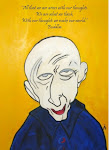Art cards continue to gain popularity
Today there are ATC swaps in almost every major city around the world.
What are Art Cards, ACEO’s, and ATC’s?
Surprisingly, art cards have been around for hundreds of years. These three terms are so similar that sometimes they are used interchangeably. ACEO is an acronym for Art Cards, Editions and Originals. Therefore, ACEO is the modern term that describes how we exchange these cards with each other. So, for the sake of simplicity let’s refer to them as Art Cards or ATC’s.
The only requirement that is etched in stone is that they are of a specific size.
2.5 x 3.5 (64x89mm). Once you have the size down, throw out all the rules. ATC’s can be on any weight of paper, texture, color or subject matter. They can be created with multi-media or any material such as etching, oil, collage or watercolor.
In the 14th century nobles, royals, and wealthy merchants hired artists to paint art cards of their daughters to arrange marriages. Since there were no cameras, it was a convenient way to provide an unbiased image to potential suitors. After all, beauty is in the eye of the beholder.
This brings us to our next true story from English history.
With trepidation in his heart, King Henry 8th, commissioned Holbein a respected artist of the time, to paint an art card of his betrothed, Anna Von Cleve. She was to be wife number four. Great distance separated them so he relied upon the art card. He approved of the image and agreed to marry. New Year 1540, marked the day, King Henry the 8th saw Ann Von Cleve, which he likened to a draft horse once he finally gazed a true eye upon her face.
The king swore the ATC artist had embellished the portrait with finer features than were truly hers. He soon divorced her for the next wife number five, Katherine Parr. See henrytudor@bleyonder.co.uk for more photos of Anna Cleve.
Another period in history emerged for the art cards. Renaissance artists began to abundantly trade cards. If you are trading art cards you are in company with the likes of Vincent Van Gogh. He as many others used this method as a way to share style with contemporaries as well as show off new techniques to competitors. ATC history credited these artists as the first to use both sides of the art cards. The image was painted on one side and a brief description on the other.
Today art cards are the rage in many digital forms using technology which took off in the 90’s. The celebrated Swiss artist, M. Vanci Stirnemann, in 1997, used his style and techniques to secretly create 1200 cards by hand. Much to the surprise of the patrons in Zurich, Switzerland, his entire exhibit was comprised of only ATC’s. Then he wowed them again when, on the last day of the exhibit in, he encouraged participants to make their own in a classroom setting. The movement took off and now you can find artists of all backgrounds presenting theirs personalized ATC’s.
Today, artists can use technology to make the cards and also use modern technology to market them. ATC’s can do the work of an agent as far as getting an unknown artist’s work in front of the right people. Cards are sold and traded on the Internet in a huge way using online stores like EBAY. You can also find many websites specifically to trade or sell ATC’s. People that could not afford but appreciated and desired work from a specific artist can now buy art cards and ACEO. New artists can create cards for the entire world to see their work can open doors of excitement and opportunity. Fabulous artists that don’t have the personal capacity or wear withal to travel the world and do exhibits can be seen. Being discovered can be as simple as learning to make your own Art Cards. Technology and ACEO’s have met at a happy point ushering in an ever-changing art world.
Art News from
The Global Village Women
HOW TO MAKE ACEO, ART CARDS
Websites to help you www.arrachmeart.com, www.art-card.org, www.artmakr.com
Specifications
1. 2.5 x 3.5inches, 64x89mm. This is the exact size required. No deviations can be accepted.
2. Limited editions are more desirable but not required
3. COA- Certificated of Authenticity is appreciated by the collector. You can use a stamp to print directly on the back of the card or hand write. If you hand make your card you will need one of these methods. If you print your cards you can create sheets of COA’s and print them out onto the back of your ATC sheet. Make sure you line them up correctly so the front matches the back.
Name of Artist
Title
Edition number 1-25 (example)
Signature of Artist
Printing
1. You will need the program Adobe Elements. This is the easiest program I have found to size your image to the required specifications. Since it is not a standard size a printer’s manufacturer’s format will not offer this option.
2. After you have sized it, save. Now open it in your standard Microsoft word program.
Click on, add image. Copy it, and then click on paste until you have 3 rows of three.
A standard 8” x 11” piece of paper will give you 9 ACEO cards.
3. Paper- The quality of the print is not based on the printer rather it is the paper quality that determines the end result. I use Royal Brights Matte Photo paper.
4. Printers-I use two printers, The HP All in One and the Epson Claria High Def 1400 Stylus

